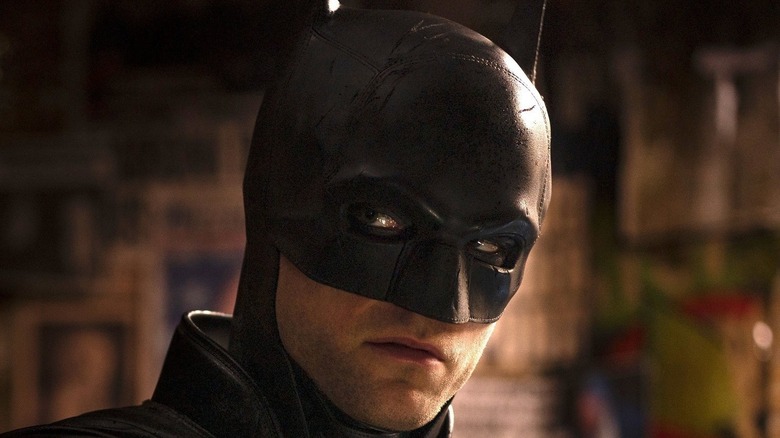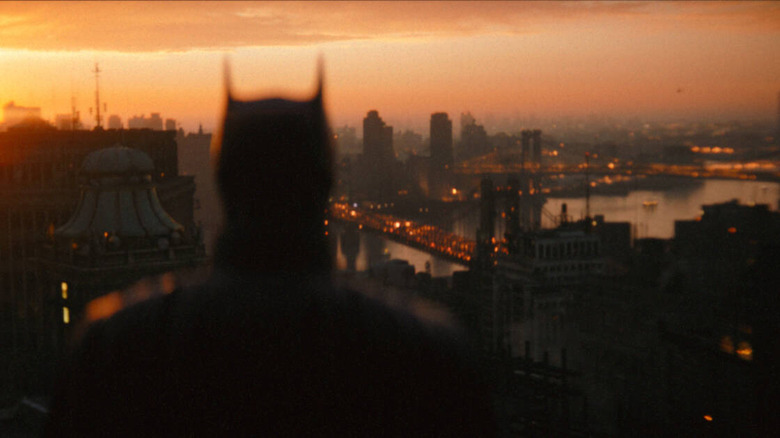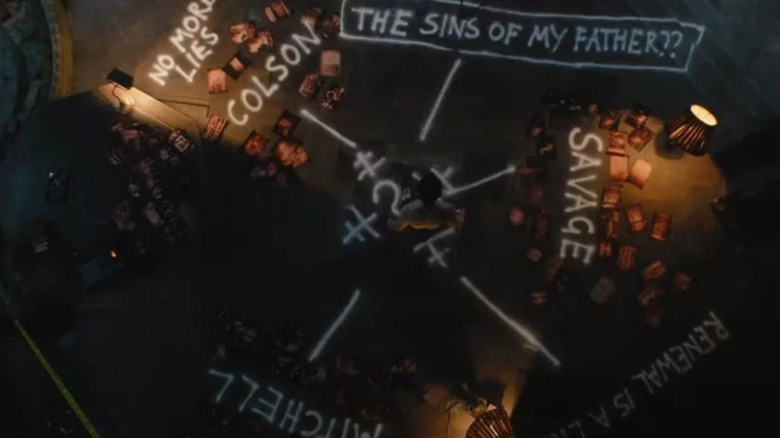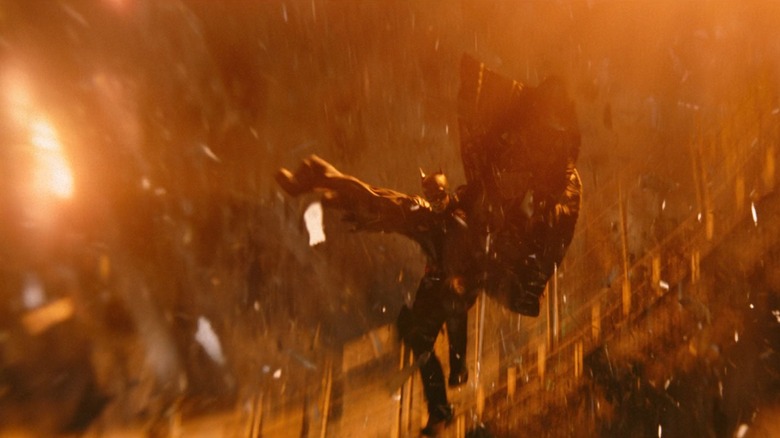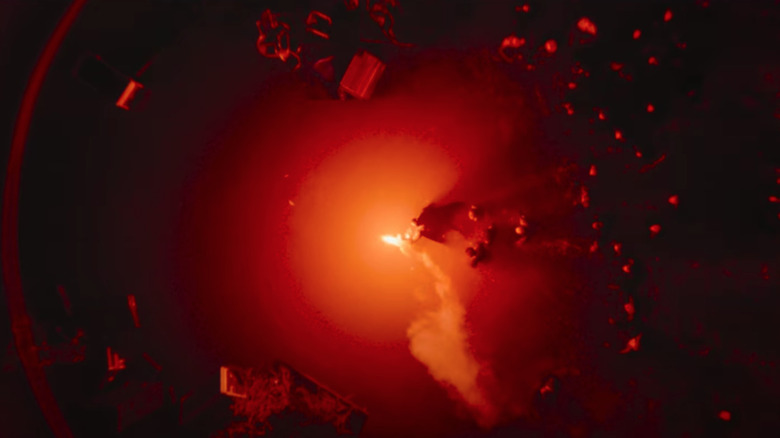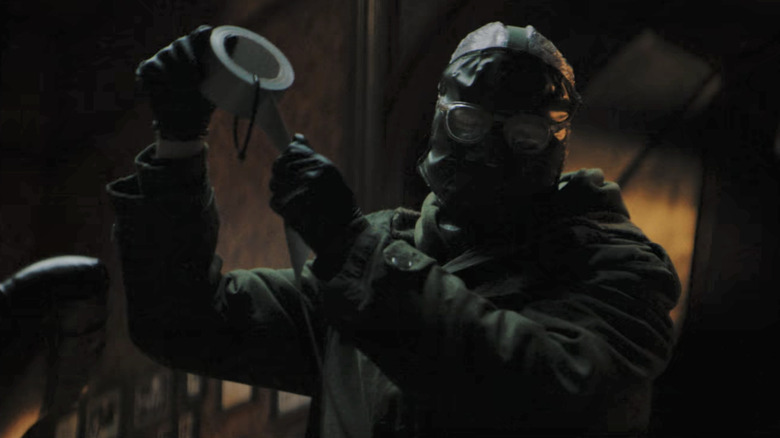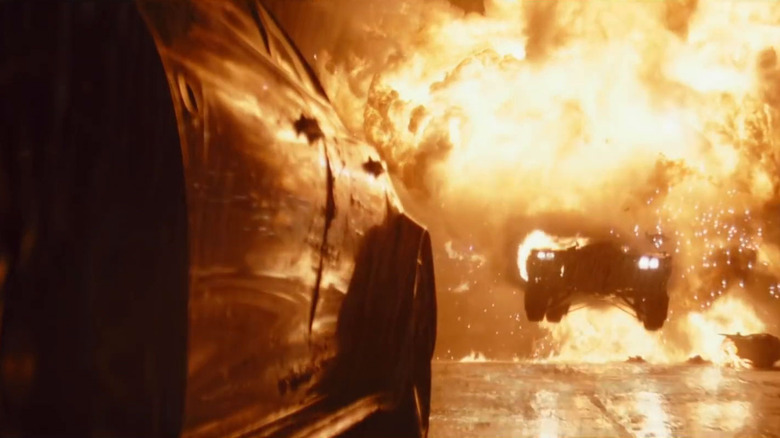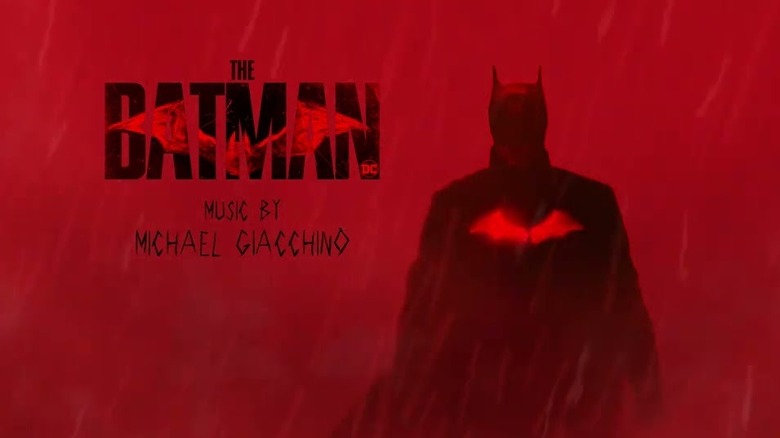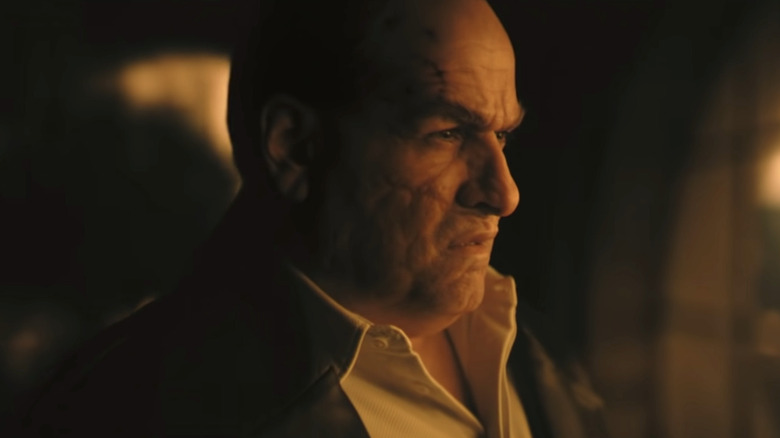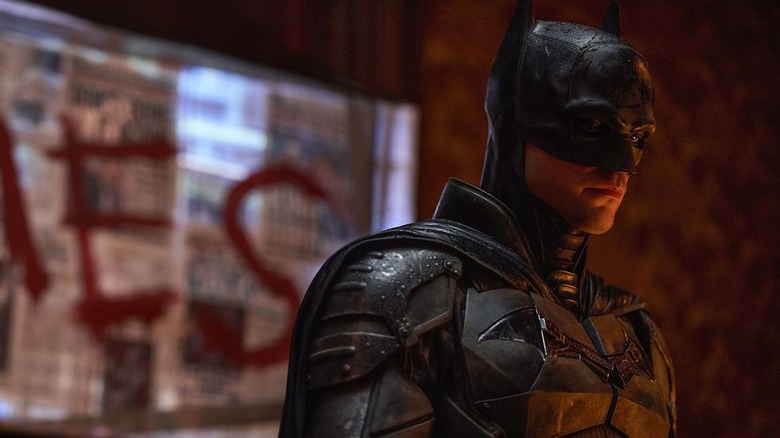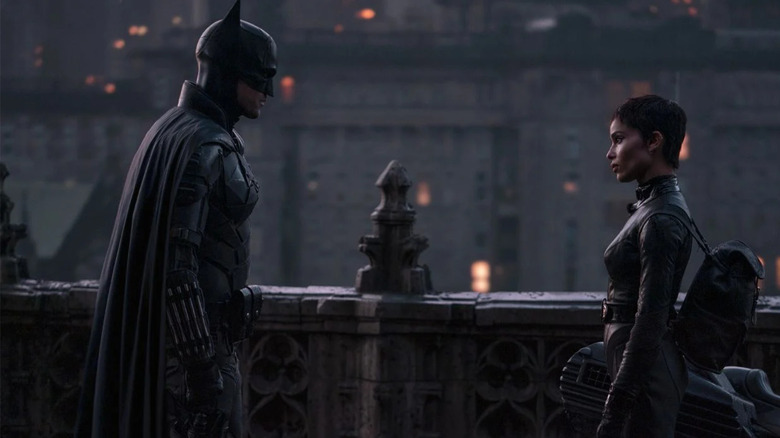Things The Batman Does Better Than Most Marvel Movies
"The Batman," directed by Matt Reeves and starring Robert Pattinson as the Dark Knight, in many ways feels like a breath of fresh air amidst a movie marketplace saturated with superhero movies. That's not to say it's particularly original (it borrows many elements from various "Batman" comic runs as well as the Christopher Nolan trilogy), but it stands out in an era where the genre is dominated by the Marvel Cinematic Universe and various attempts at imitating the Marvel formula.
The MCU has been wildly successful in large part because its films generally maintain, and sometimes even exceed, a solid standard of quality. While the Marvel films are typically good, however, there are many weaknesses that most entries in the franchise share. "The Batman" is aiming for different goals than practically everything in the MCU so far, but nonetheless, there are multiple grounds of comparison in which "The Batman" far exceeds what the MCU is typically capable of.
A truly lived-in setting
With a few noteworthy exceptions such as Wakanda in "Black Panther" and some of its intergalactic locations, the MCU generally doesn't place a huge emphasis on its settings. This is in part because the MCU is essentially the same our world, albeit with super-beings. This is a fine strategy for making its stories feel real without needing to spend a lot of time on world-building, allowing viewers to fill in the blanks based on their own experiences. Christopher Nolan's "Dark Knight" trilogy utilized this strategy as well, simply treating Gotham as if it were Chicago, New York, or whatever real city the movies were filming in.
But it's world-building where "The Batman" excels most of all. Its Gotham is a marvel of production design, as gothic as Tim Burton's version but with less cartoonishness. Extensive thought has been put into not just how this distinctive city looks, but how it feels, what it's like to live there, and why this corrupted place needs Batman in the first place. The sense of place in "The Batman" not only exceeds the majority of the MCU, but much of the superhero movie genre as a whole.
Breaking from the action movie formula
As much as Marvel tries to hype the variety of stories in its many movies, it's clear that the MCU mostly sticks to a certain formula with minor variations. They might talk up "Captain America: The Winter Soldier" as a political thriller, "Ant-Man" as a heist movie, "Eternals" as a philosophical drama, and so on — but despite these different flavors, these movies generally end up in the same place as action movies building toward a CGI-filled third act battle. Even something genuinely distinctive like the Disney+ series "WandaVision" has to succumb to the typical Marvel climax in the end.
When Warner Bros. hyped "The Batman" as a neo-noir detective film, however, the studio actually gave us what they were selling. There are still the action scenes you expect from a superhero movie, but there are far fewer of them than most of its contemporaries. The vast majority of the three-hour runtime is spent investigating crime scenes, interrogating suspects, and struggling to uncover conspiracies. Critics aren't kidding when they've compared it to the crime thrillers of David Fincher; it has more in common structurally with a film like "Se7en" or "Zodiac" than with "The Avengers" or even "The Dark Knight" (which still operated primarily as an action film, albeit one different from the standard blockbuster mold).
Consistently great cinematography
Though the Marvel films have their moments of beauty, the studio's insistence on a consistent house style has resulted in a tendency towards bland visuals. Even when the technical skill on display in these movies is impressive, the general aesthetic has been described as washed-out and even ugly. This is absolutely not the case with "The Batman," which ranks among the most visually stunning blockbusters in recent memory.
Shot by Greig Fraser, the cinematographer who earned Oscar nominations for 2016's "Lion" and 2021's "Dune," "The Batman" is a cinematographic achievement that deserved to be remembered come awards season. Filming a movie set almost entirely at night and in shadows is a challenge, but Fraser keeps the images clear and beautiful even when the darkness is overwhelming. "The Batman" is particularly inventive with light sources, using everything from gunfire to the engines of the Batmobile as substitutes for traditional lighting.
Caring about civilians
Whether it's that they have so many heroes to focus on or because their stakes so often get cosmically huge, the Marvel movies don't really expend much emotion for ordinary people living in their universe. While the films aren't as callous about civilian deaths as controversial third act of "Man of Steel," the issue is treated as something to be brushed away with a few lines (as in "The Avengers"), an abstract concept to be argued about (as in "Captain America: Civil War"), or otherwise just not a concern. The number of action scenes centered around good guys and bad guys clashing at each other outnumber those centered around the good guys directly rescuing people.
In large part because its version of Gotham feels so real, the threats faced by the city's civilians in "The Batman" feel extra intense. Batman's character arc is defined by his relationship with the people of Gotham: He goes from someone even the people he's rescuing are afraid of to someone who shows leadership in crisis and can bring hope when it's desperately needed. This is the movie where the most powerful acts of heroism aren't about defeating enemies, but about caring for your neighbors.
It's genuinely scary
This might not be the most even grounds for comparison, because the Marvel movies generally aren't trying to be scary (with the notable exception of "Doctor Strange in the Multiverse of Madness," which has been described by screenwriter Michael Waldron as "veering into the horror world"). As such, it's no slight on the MCU to say that "The Batman" is significantly scarier than anything the MCU has attempted thus far, and it is yet another thing Matt Reeves' film excels at.
The Riddler's grotesque killings push the limits of the PG-13 rating to the extreme. If anything, the restraint the film shows in regards avoid to R-rated graphic content makes what's implied all the more disturbing. From ticking bombs to topical political nightmares to one of the most startlingly believable depictions of near-future climate disaster, there are multiple sequences in "The Batman" that could haunt your nightmares. Needless to say, think twice before letting the kids watch.
The special effects always look real
This is also something of an apples-to-oranges comparison, because the MCU's special effects spend a lot of time depicting things significantly less "real" than anything in "The Batman." Even with that in mind, however, Marvel Studios has some notoriety for inconsistent special effects quality. The stuff that looks good looks great, but there are still many questionable moments of rushed or lower-quality effects in otherwise high quality movies. In terms of consistent realism, "The Batman" beats basically every Marvel movie when it comes to special effects.
Some of the special effects in "The Batman" looks real because they are real. The Batmobile driving through fire is a real practical stunt. However, there's also a lot of CGI used so seamlessly in the film that most viewers won't even be aware certain shots are effects shots. "The Batman" makes extensive use of ILM's StageCraft system, previously used on "The Mandalorian," which combines projections with virtual reality technology to allow for the most realistic cinematography of CGI backgrounds.
A memorable musical score
Along with complaints about bland cinematography, one of the most popular criticisms of the MCU is that the musical scores tend to be forgettable. Every Frame a Painting did a video essay on this subject in 2016, and while there have been improvements since then (Ludwig Göransson's score for "Black Panther" won both a Grammy and an Oscar, and the "Avengers" theme music certainly became more memorable after its usage in "Infinity War" and "Endgame"), the scores still typically aren't the highlights of the Marvel movies.
In contrast, nearly everyone who loves "The Batman" can't get the film's main theme by Michael Giacchino out of their head. It rivals the classic Danny Elfman theme from the 1989 "Batman" and "Batman: The Animated Series" among the definitive musical interpretations of the Dark Knight. But a great Batman theme isn't all Giacchino's score excels at. From the chilling deconstruction of "Ave Maria" used for The Riddler and to the sensual noir music that accompanies Catwoman, the soundtrack to "The Batman" works masterfully as both music in its own right and as a tonally-perfect accompaniment to the movie.
Multiple great villains
Let's be fair and acknowledge that Marvel Studios has gotten a lot better at villains from Phase 3 of the MCU onward. Vulture, Killmonger, Thanos, and Wenwu are all stand-out antagonists and among the most interesting parts of their respective movies. In its first two phases, however, the MCU had a major villain problem, with no one aside from Loki and (to a lesser extent) Ultron providing much in the way of entertainment or interesting personalities. The focus was on developing a wide range of heroes, with their enemies being an afterthought.
"The Batman" has three major villains (The Riddler, The Penguin, and Carmine Falcone) and they're all superior to the non-Loki villains of the MCU Phases 1 and 2. Paul Dano's Riddler is the most significant villain in moving the plot along, and he's also the scariest — but he still has complex motives for why he's committing his horrible crimes. Colin Farrell's Penguin is a more fun gangster character, ready for his spinoff show, and John Turturro's Falcone oozes menace as the villain with the most personal connection to the Wayne family.
Interrogating its hero's privilege
If Bruce Wayne has a "superpower," it's that he was born into immense wealth. The claim that he'd help Gotham more by giving his money to charity than by dressing up as a bat every night beating up criminals are so common that it's become a cliché, but "The Batman" does an impressive job in directly addressing in the way it addresses the failings of Thomas Wayne's charity work. It's fully aware of how Bruce being a heroic billionaire is something of an anomaly, and directly calls out the ways in which his racial and economic privilege affects him. At two points in the movie, the "world's greatest detective" misses obvious clues because of his sheltered upbringing.
The big comparison to Bruce Wayne in the Marvel universe is Tony Stark. While the MCU acknowledges the ways in which Stark Industries' business practices have caused countless problems for everyone else, it's a lot more debatable how successfully holds Tony to account for his actions. Some have even called him the MCU's biggest villain. His attempt at redemption by "privatizing world peace" makes for fun action movies but is politically problematic in its own ways that the MCU never addresses too deeply, in contrast to how "The Batman" confronts the inherent problems with its hero head-on.
Works as a satisfying, self-contained story
The MCU is exceptional at what it does in terms of building an interconnected franchise where audiences feel they have to see everything. Even the films that do work as stand-alone stories are designed with call-backs and future teases in mind. Between the epic conclusion of the Infinity Saga and the multiverse adventures in Phase 4, the MCU has only grown more confident in its viewers' familiarity with past movies — and in the case of "Spider-Man: No Way Home," movies that weren't even part of the MCU.
This is all well and good, but we can't dismiss the value of a well-told self-contained story that doesn't feel like it's putting off any important narrative or character development for sequels. "The Batman" might be the start of a "cinematic universe" of its own, with sequels and HBO Max spinoffs on the way, but it's successful as a complete story. Only one particular scene feels a bit too Marvel-esque in terms of playing like a blatant sequel tease — and as director Matt Reeves tells Variety, that's not actually the case.
